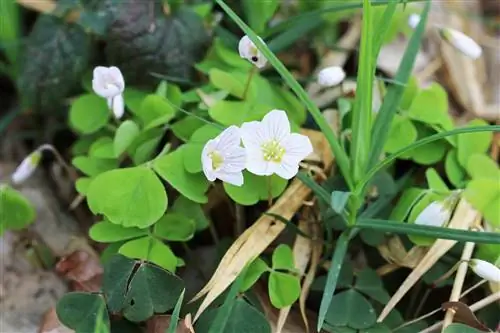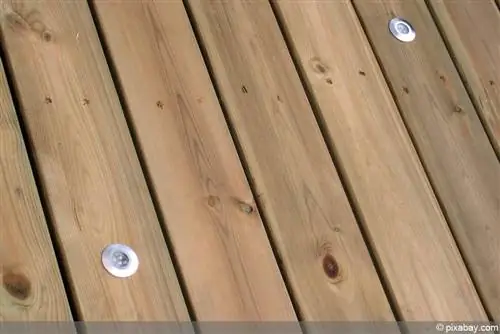- Author admin [email protected].
- Public 2023-12-17 03:39.
- Last modified 2025-01-24 12:45.
Sorrel is widespread all over the world and has many species. In Central Europe there are at least three genera that are considered weeds. Wood sorrel grows herbaceously and reaches a height of 5 to 15 cm. The leaves resemble a clover leaf even though they don't belong to each other. The leaves of the wood sorrel are slightly fleshy, so the plant is also very easy to care for in terms of water requirements. In addition, the color of the leaves is green and they are always found in a three-leaf arrangement.
If you eat the leaves of the sorrel, they taste slightly sour. The flower color varies depending on the genus and ranges from a delicate white to a strong purple. Wood sorrel prefers forest soils in order to grow well.
Sowing and propagation
If you do not consider wood sorrel to be a weed in any way, you can sow it in the garden. The seed nodules are available to buy in a garden center or a well-stocked hardware store. The seeds are sown generously across the garden soil. You can also sow the sorrel in a pot. To do this, put a few brood nodules in the pot and cover them lightly with a little soil. Until the sorrel is visible, you should water it well. If you already find wood sorrel in the garden and are impressed by its beauty, you can also propagate it by division. Remove the plant from the soil and divide the Oxalis plant from the roots. After division, the clover is put back into the ground and watered well. Irrigation ensures that the soil bonds well with the plant roots and the wood sorrel can grow well. There are also pre-grown plants available in specialist garden shops, which are usually sold under the name lucky clover.
Plants
Once you have grown the plants, they can simply be planted in the soil of the garden. Spring is best for planting. In terms of weather characteristics, April is ideal for planting sorrel.

Repotting
If you planted the wood sorrel in a pot at the end of April, it needs well-moist soil. The plants should be visible on the surface by autumn and from this point on they will no longer be watered as the plants will shrink. As soon as the plant becomes visible and is 3 cm high, you can plant the wood sorrel in the ground. Repotting is not necessary if it remains in the pot.
Care
The lucky clover, as wood sorrel is also called, requires light care:
- The soil should be low in lime and permeable.
- The place for the wood sorrel should also be chosen in a sunny place.
- Partially shaded locations are also suitable.
Sorrel does particularly well in rock gardens, where it enchants the landscape with its white flowers from April to June. When watering, you should make sure that the water is almost lime-free. Because sorrel cannot handle lime. It is best to use water from the rain barrel.
- The wood sorrel can be left outdoors in winter, but requires good cover with leaves or pellets.
- Compost or foil are also suitable, although foil provides even more protection from rain and snow.
Location
The sorrel loves it sunny. The flowers only open when the sun shines on the plant. The same applies when the sun sets in the evening - then the flower closes and lies down to sleep. It is fascinating to observe this spectacle, which only a few plants can achieve.
Pouring
Rainwater is best for watering. This contains little lime. Lime is not good for the plant and should therefore be avoided at all costs. The plant does not require watering in winter. Only in summer should the soil always be kept moist.
Fertilize
The wood sorrel does not need to be fertilized. It is completely sufficient if the compost that was placed on the plant for overwintering releases nutrients into the soil. If you cover the sorrel with foil, you can add some organic fertilizer or nettle manure to the sorrel in the spring. However, fertilizing is not absolutely necessary.
Cutting
The wood sorrel does not need to be cut as it only reaches a maximum height of 15 cm. However, you should remove the wilted leaves and stems after winter so that the plant can grow again.
Wintering
So that the sorrel can overwinter optimally, it should be covered with leaves or plant residues. Compost is also suitable. The best way to proceed is to cover it with foil. The film protects the sorrel from rain and snow.

Diseases and pests
Since sorrel has a bitter taste, it is rarely attacked by pests. The sour taste is a deterrent for many pests, making the plant a very good garden plant.
What you should know about sorrel in brief
For many people, wood sorrel is a weedy plant. However, anyone who sees the sorrel in its bloom will be fascinated by its beauty.
- Sorrel is very easy to care for and requires little attention.
- Sorrel looks great in rock gardens or on dry stone walls.
- In the summer, clover needs a little water every now and then.
- It is also practical that the wood sorrel can stay outdoors in winter.
- For beginner gardeners, planting sorrel is associated with quick success.
- A special feature of wood sorrel is that the leaves close in the dark.
- It then looks as if the plant is sleeping.
- Sorrel blooms from April to June, after which the plant dies.
Many people are starting to panic now because they think the plants have died for some inexplicable reason. - No reason to worry! Under ideal conditions, the plants sprout again from their tubers. When watering, only use lime-free water, preferably from a rain barrel. Wood sorrel feels very comfortable in the company of hostas, sedge or gunsel. In winter, sorrel should be covered thickly with leaves or shredded plant parts. Compost and foil can also be used; above all, a foil cover protects the plants from a lot of rain and snow.
There are now many cultivated varieties of Oxalis that are commercially available. These are usually sold as lucky clovers. Some varieties are also intended as houseplants. To clarify this, you should find out more about the individual varieties in the flower shop. There are also varieties that are better suited to shade. Only sorrel is suitable for consumption, and only in small quantities, due to its high oxalic acid content. People with kidney disease should avoid consuming sorrel completely. The leaves of Oxalis can be mixed in small quantities with salads, or mixed finely with quark or yoghurt and enjoyed as a spread or dip.






